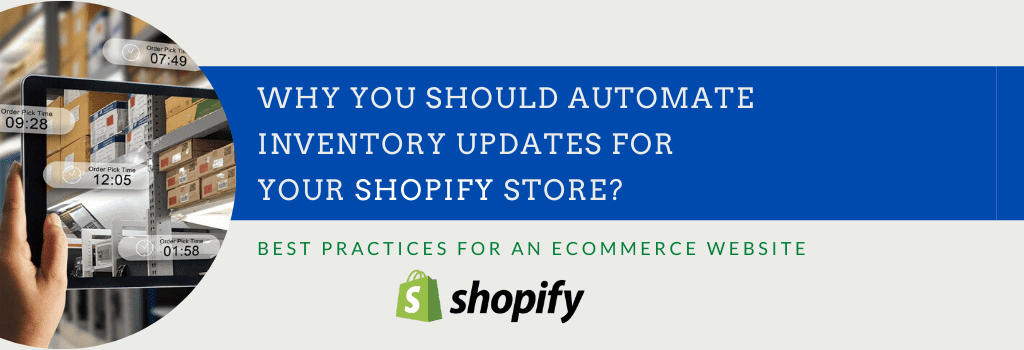Why You Should Automate Inventory Updates for Your Shopify Store?
Last Updated on May 24, 2024 by Tatyana Vandich
This post was updated to reflect current trends and information.
One of Shopify‘s main challenges is managing your inventory. Without well-organized inventory management, you can lose a lot in sales. A bad situation is when you sell products that you no longer have in stock, which can lead to additional costs for refunding money, irritating customers, and losing loyalty to your store.
Manually updating your inventory level in the Shopify Admin Center can be impractical and you also lose a lot of time and you have no guarantee that you will avoid errors. Thus, how to avoid these problems?
Let’s first look at what Shopify is and how the ordering process takes place.
What is Shopify and How Does it Work?
Shopify perhaps is one of the most popular brands in the world of e-commerce, but not everyone knows how it works. Simply put, Shopify is the software you pay its usage, based on a monthly subscription, under the SaaS model. It allows you to create an eCommerce site and use the solution payment gateway to sell both digital and physical products, to customers around the world.
When you setup your Shopify store, you can choose one of 3 available plans:
- Basic Shopify – $29 monthly
- Shopify – $79 monthly
- Advanced Shopify – $299 monthly
Shopify in no way limits the number of products that you can have in your store. You can sell an unlimited number of items on every Shopify plan.
Many experts recognize Shopify as the best solution in the e-commerce market for investing in the growth of their online store.
Typical Workflow for Online Orders
Understanding Shopify order processing is a fundamental part of your e-commerce business. Let’s briefly review the main stages of Shopify order processing when your Shopify store is not synchronized with your business systems.
Every Shopify online order goes through certain stages. Each of these stages requires a different action in your Shopify store. You can configure Shopify to automatically perform these actions or process them manually.
Capture Payment of a Placed Order
When a client makes a payment by credit card, payment information must be received and sent to his bank for processing. You can receive payments manually or automatically. If you set a manual capture, you will need to capture funds for each order from the Shopify orders area. In this way, (if you configured your settings for manual capture funds), you will not automatically receive payment from orders. And attention, you won’t be able to collect any money for an order after the authorization period ends.
Thus, manual payment management requires a lot of time and effort, especially if you have many orders.
But if you just automate the capture payment, without automating inventory updates, there is a high risk of getting money for goods that are no longer in stock.
Fulfill the Paid Order
When a client buys something from your online store, this information appears as a new order in the Orders page of Shopify. Simultaneously you receive a new order notification by email. The customer receives an order confirmation by email. The fulfillment procedure typically includes the following stage:
1. You log into your ERP/accounting system to create an order record from the Shopify store.
2. Search for customer records in your ERP/accounting system. If you do not find customer information in your system, you must manually enter all the information about the new customer.
3. To account for purchases, you need to manually adjust your inventory levels. This is more complicated than it seems at first glance, because your product identifiers (Shopify creates a unique product ID for every item you sell) in your online store may not exactly match the SKUs (Stock Keeping Unit- the code that identifies the product within your business).
4. After entering and adjusting all the related order information, you can proceed with the order, namely: picking and packaging items, labeling the order for shipment, shipping the package with a mail carrier. The steps for fulfillments may be different depending on the fulfillment method used:
- Fulfill own orders. You execute orders yourself, packing and sending your goods.
- Dropshipping (fulfillment services). Dropshipping partners stores, packs, and ships the goods for you to your customers. The typical dropshipping services that integrate with Shopify are Oberlo Dropshipping and Fulfillment by Amazon but it could be other services.
- Custom dropshipping Customs dropshipping services realize your orders when they receive a request by e-mail. This request is generated when you mark an item as fulfilled in your Shopify store.
5. After completing the order, you must take note of the shipping information and return to your Shopify store to send this information to the customer for tracking.
6. If you use CRM you need to manually update the information to reflect the sale you just completed.
Shopify Refund, Return, or Canceling Orders
If the process described above seems familiar to you, most likely you are tired of manually entering data between business systems and your store. Either you must incur large salary costs for employees who are responsible for data entry. But the worst part is that you often find errors as a result of re-entering data. Thus, part of the orders ends with a return.
Did you know that according to e-commerce returns statistics 65% of all returns are the merchant’s fault (whether it’s an incorrect size, color, etc.) But for sure, your goal is to minimize returns in your store and increase customer satisfaction.
Our recommendation: to better manage your business we highly recommended automating all your order processing at each stage.
Inventory Updates Issues
Another big common problem in online shops is inventory updates. Inventory levels in the online store and business system are never synchronized; as a result, it is typical in such case to find companies issuing lots of refunds to offset ordered goods that are not available for shipping.
It’s no secret when returning the goods and reimbursing their payment, not only profitability is reduced, but unexpected order processing work is added.
Shopify takes its share from each transaction that occurs in your online store. Fees are: 30¢ for every online transaction, plus 2.9% to 2.4% depending on your plan. Even if you activate Shopify Payments (that available only to stores in certain countries) you still have to pay for each transaction.
Although the fees for Shopify Transactions are not so bad, but if the company has problems with inventory synchronization and often must make refunds, they are not happy to pay the transaction fee.
Some e-commerce owners recommend put in the financial plan “fund returns”. They say start by depositing 10% of the income into the “return fund”. And if experience shows that more or less is needed, change the percentage.
This may seem reasonable, but we recommend that you invest better in automating your business, which will improve the performance of your store at every stage and increase customer satisfaction and profitability.
Save Time and Money with Fully Managed Shopify Integration Service
Do you need an effective integration solution to automate your order processing, update an inventory and help you sell more on Shopify?
Our goal is to save the time of entrepreneurs so that they take care of the e-commerce routine problems as little as possible. We take this job on ourselves. We reduce the processing and delivery time of a Shopify order and make it faster by integrating your Shopify store with another system that you use to run your business.
Contact us today for a free consultation!
RELATED POSTS:
Must-Have Integration between E-Commerce and Business Systems
9 Major E-Commerce Trends That Will Help Grow Your Online Business
PRICING PACKAGES: Shopify Integration
Shopify and Microsoft Dynamics Nav Integration: Things you should know
Secrets and rules of Shopify integration with your ERP or CRM


